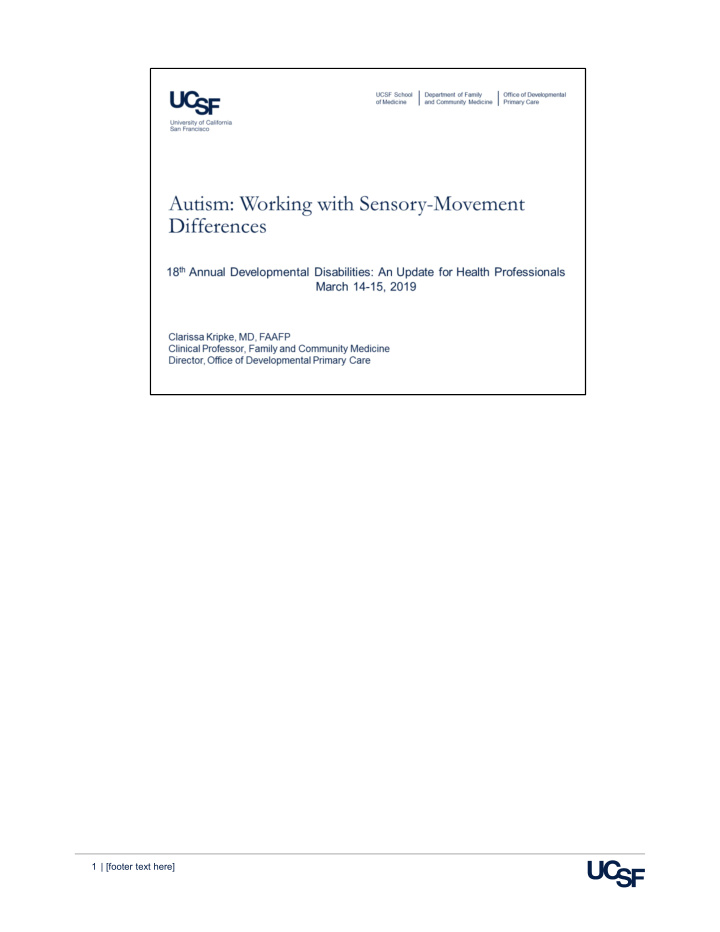



1 | [footer text here]
2 | [footer text here]
• The reason I wanted to give this talk is because I have come to understand that a lot of what we know for sure about autism, just isn’t so. We have developed services for autistic people which are based on the belief that autism is primarily a psychological problem characterized by deficits in social understanding, restricted behaviors and interests, and cognition. But I have come to believe that autism is better accommodated and supported when it is understood as a neurological condition. [pause] Increasingly, people working in a neurological paradigm are achieving remarkably good outcomes, especially for those who don’t speak or whose speech is unreliable communication, and for those with prominent symptoms of dyspraxia. Dyspraxia is difficulty coordinating movement. 3 | [footer text here]
• Ten years ago, we thought that autism was a thing. Find the gene! Maybe it’s vaccines? It’s an epidemic and a crisis! We’ve mostly moved through that, thankfully. But remnants of it sometimes rear its ugly head on occasion. • A diagnosis of autism doesn’t correlate with any specific trait or characteristic. People can be super smart or have significant cognitive challenges. They can be organized or have executive function problems. They can be a competitive surfer or use a wheelchair. They may or may not have seizures. They may have normal, very acute or scrambled senses. They may be blind or deaf. They may be polite and regulated to a fault, or have significant anxiety, behavioral, or mental health problems. • Historically, autism was defined by psychiatrists who were rooted in early 20 th Century cultural ideas about intelligence, eugenics, and social hygiene. Early work in treatments was based on Skinner’s framework. Skinner believed that observable behavior is the only relevant target of treatment, and that controlled experimental designs are the only relevant way to evaluate their effectiveness. In Skinner’s paradigm, we know a treatment works if you present a stimulus, and the person consistently responds in the way you expect . For Skinner, thoughts, feelings, emotions, or other non-observable, or less measurable aspects of cognition are not relevant. Skinner thought we don’t have to ask questions about why people behave the way they do beyond a simplistic analysis of the immediate stimulus, behavior, and consequence. Medical causes of behavior changes aren’t assessed. [pause] But of course what autistic people think and feel is critically important. Their past experiences and traumas are relevant. Their health status is crucial. Understanding the reasons why they do what they do is core to developing good support. • Autism is defined in the Diagnostic and Statistical Manual of the American Psychiatric Association. But even the APA itself has begun to question the validity of the DSM classification scheme. It is based on professional consensus about clusters of psychological or behavioral symptoms rather than on more objective biological data. The fields of psychiatry and neurology are growing closer together every day as our understanding of the basic science in both fields improves. • It is pretty clear that there isn’t one autism. It is not a single condition with a range of presentations from mild to severe either. Autism is a catchall diagnosis that includes a very wide range of etiologies, traits, characteristics, strengths, challenges, genes, environmental influences, and biology. 4 | [footer text here]
Autistic people have a wide range of strengths and challenges. People with significant support needs can also have great gifts. Different parts of the brain perform different functions. For example, there are different spots for speech, language, and reading. They have connections between them. But the connections can be too weak or too strong. For example, someone who speaks may have trouble reading. Someone who signs English may not be able to speak. Someone who reads and who has language, may also have trouble speaking even though they can write. Applied Behavior Analysis, the most common treatment for autism, assumes that what you see is a good representation of what is going on in the brain. But it isn’t. Many autistic people have more going on inside than they can show. 5 | [footer text here]
Recommend
More recommend